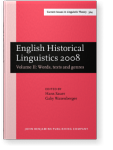Abstract noun ‘suffixes’ and text type in Old English
The present study investigates six elements (-dōm, -hād, -lāc, -nes, -rœden and -scipe) which can form abstract nouns with a noun as a first element in Old English. On the basis of West Saxon selections from the Helsinki Corpus, these elements are classified into two groups according to frequency and productivity, both synchronically and diachronically. Among high frequency elements -hād reaches a stronger productivity than -dōm and -scipe, whereas less frequent -nes is more productive than -rœden and -lāc. A particular focus lies on different prototypical text categories, which reflect general usage patterns while showing idiosyncratic characteristics and display conservative or progressive features in view of developments in Middle English. With its support of -lāc and -rœden religious writing can be shown to promote conservative aspects of language use more than non-fiction. The findings from this investigation form a basis of comparison for future studies on Middle English word formation.
